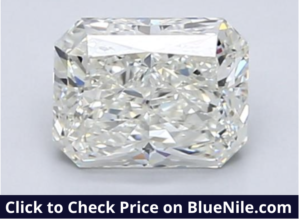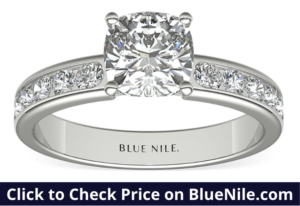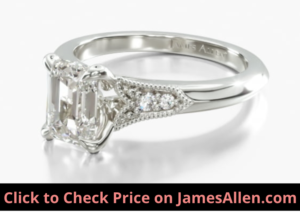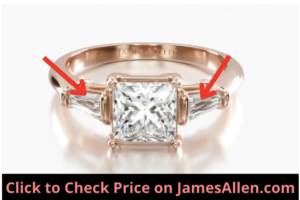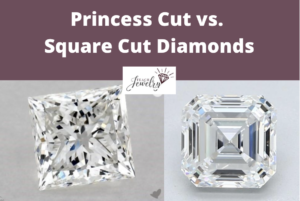
Diamonds like princess and other square-cuts are an appealing alternative to the classic round cut. They’re known as fancy shapes and each offer unique qualities when placed in an engagement ring.
The main difference between princess cuts and other square-cut diamonds is princess cuts have a length-to-width ratio equal to or close to 1.00, brilliant cut facets, and sharp corners. Other square-cuts often have higher length-to-width ratios, step-cut facets, or sloped edges.
Let’s compare princess versus square-cut diamonds, so you’ll know how to decide which is right for you.
Princess vs. Radiant Cuts
The primary difference between princess and radiant cuts is princess cuts have sharp corners, and the corners on radiant cuts are sloped to create eight edges.
Here’s an image of these two cuts side-by-side, where it’s easy to spot the distinctions.
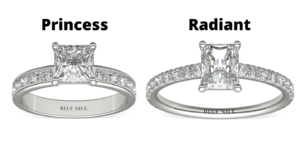
Although radiants can be cut as a square with a length-to-width ratio of one, they’re often closer to 1.25 and are obvious rectangles. The example above fits this description.
Radiant cuts have 70 brilliant facets. Another distinct feature is it’s a square-shaped diamond that has those triangular facets on the pavilion and crown.
It demonstrates strong brilliance and fire but doesn’t surpass that of a round cut.
In fact, the design is a combination of round and emerald cuts. The facets resemble the former, but its overall shape mimics the latter.
If you’re comparing the light performance of princess versus radiant cuts, princess cuts have a slight advantage. They were designed to rival the sparkle of round cuts while still offering an alternative shape.
A benefit of radiants over princess cuts is they’re more durable. The four cropped corners are less prone to chipping than the sharp ones on princess cuts.
So while you might decide to protect your princess cut with a double claw or bezel setting, a simple four-prong setting for radiant cuts is often sufficient.
Here’s an example of a radiant cut with this style of setting and channel-set accents.
It’s a sleek aesthetic that still keeps the attention on the main diamond.
Because princess cuts often have a more shallow cut compared to radiants, they don’t retain as much color. You might have an easier time finding a princess cut that appears colorless to the naked eye.
For example, check out this princess cut with a J color grade.
Even with a high-resolution image, it doesn’t show yellow.
But the shade of color is more obvious in this radiant cut with an identical grade.
The same principle is true for clarity.
While you could find princess and radiant cuts that are eye-clean in the slightly included (SI1 and SI2) range, you might decide on a very slightly included radiant cut (VS1 or VS2).
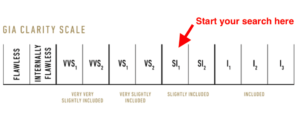
By viewing the diamond in-person or through high-quality images, you can land on the right clarity grade for your ring.
Princess vs. Asscher Cuts
Princess and Asscher cuts are both square. The differences are that Asscher cuts have a:
- deeper pavilion
- higher crown
- cropped corners
- step-cut facets
In this side-by-side image, they aren’t as easy to distinguish as the comparison above.
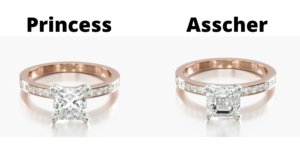
An Asscher cut’s 58 facets are arranged in parallel lines across the table, creating a “hall of mirrors” effect in this octagonal diamond.
The step-cut facets result in less brilliance compared to princess cuts.
Instead, elongated facets produce a warm glow.
It’s why many buyers choose side stones, a halo, or pave for their Asscher cut diamond rings.
For example, this 14K white gold ring produces a strong sparkle from its halo and pave.
It compensates for the lack of light from the Asscher cut.
But you’ll still find engagement rings with Asscher cuts in a solitaire setting. Just don’t expect to be impressed by its glimmer.
Similar to radiant cuts, Asscher cuts show more inclusions and color compared to princess cuts.
I recommend starting with VS1 clarity and an I color grade and working your way up the scale from there.
Asscher cuts are often less expensive per carat than princess cuts. To demonstrate, I analyzed prices of 29 one-carat Asscher and princess cuts with G color and VS1 clarity grades.
In my research, the average price of a princess cut was $4,715, with a range of $4,200-$6,110.
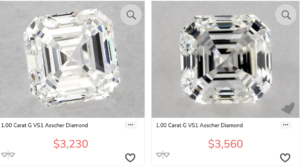
For Asscher cuts, the average was $4,156, and the range was $3,230-$5,450.
That’s a 13 percent premium for princess versus Asscher cuts.
But because you may need to choose higher color and clarity grades, or a setting with more accents, you can apply the savings to those areas.
In the end, the costs for an engagement ring could be similar.
Princess vs. Cushion Cuts
Cushion cuts most resemble the square shape of the princess cut.
In this side-by-side view, notice the similarity between their overall shapes.
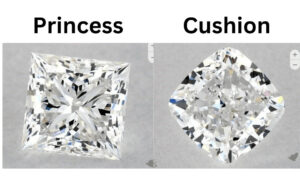
Although there are many types of cushion cuts, the classic design has a 1.00 length-to-width ratio. You’ll find them up to 1.30, where it’s an obvious rectangle.
Its outline mimics a pillow, with edges that are slightly rounded.
The 58 facets are known to produce strong fire that matches a princess cut.
Cushion cuts fit a variety of settings. One of my favorites is a channel-set ring, where small diamonds are placed within grooves.
To show you a real example, the setting below features a cushion cut as the main gem, with ten round diamonds inside the ring.
The channel-set diamonds compensate for the slight lack of brilliance in a cushion cut compared to a princess cut diamond.
If you’re comparing costs of princess versus cushion cuts, you’ll find they’re similar. The International Gem Society compiled prices of each cut for diamonds with G color and VS2 clarity grades.
They found a one-carat princess cut averaged $4,799, and a cushion cut cost $4,229. The prices of 0.70-carat diamonds were even closer, with the princess cut costing $2,188, and cushions being priced at $2,060.
This shows there’s variability in diamond prices, even if they have the same qualities.
To the naked eye, the differences between a few hundredths of a carat, or a single clarity or color grade, is often indistinguishable.
But I recommend starting your search for both at SI1 clarity and an I color grade.
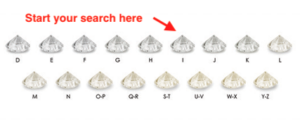
You can adjust each these characteristics for princess and cushion cuts to find the right one.
Princess vs. Emerald Cuts
Emerald cuts have elongated, step-cut facets, which distinguishes them from princess cuts.
In the image below, they’re held by the same setting, but there’s a clear difference in the overall shape.
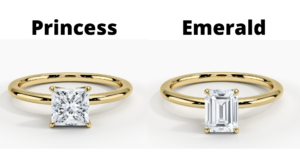
Most emerald cuts a ratio of 1.30-1.50, but some are closer to one and resemble a square.
Many of its traits mimic an Asscher cut, such as its:
- Warm, soft glow instead of strong brilliance
- Inability to hide inclusions and color
- Lower cost per carat than princess cuts
While princess cuts are considered a modern style, emerald cuts are vintage. You’ll often find them paired with settings that have milgrain or filigree to match the designs of prior periods.
This emerald cut diamond ring has Art Deco-inspired features.
Notice the small beads outlining the round cuts on each side of the emerald cut.
If you switch the image to show the ring in 14K yellow gold, the diamonds are even more prominent because they contrast the band.
It doesn’t return the same amount of light as a round or princess cut, but that isn’t the goal for every buyer.
Princess cuts are more commonly placed in four-prong solitaire settings. Their brilliance doesn’t require additional diamonds on the ring.
But if you’re searching for an alternative, consider a halo setting, where a small circle of diamonds surrounds the main one.
The halo can match the square shape of the princess cut to create a cohesive aesthetic.
Overall, choose a princess cut over emerald if you’re concerned about its fire and brilliance. An emerald cut can’t compete with brilliant-cut diamonds in these areas.
Princess vs. Baguette Cut
Baguette diamonds are another cut that’s often rectangular, but some are shaped to appear closer to a square.
The example below shows one that’s clearly a rectangle.
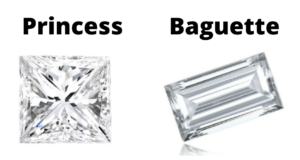
The best comparison for a baguette cut is an emerald, because its shape and facets are similar.
The difference is baguette cuts have sharp corners instead of beveled ones, which is why its outline mimics a princess cut.
Baguettes have inferior brilliance compared to princess cuts.
They show color at grades where a brilliant cuts hide it, and the same is true of inclusions. In regard to these qualities, you could put them in the same category as emerald and Asscher.
Although you won’t often find them at the center of an engagement ring, they’re a common choice for accents surrounding princess cut diamonds.
It’s a style known as tapered baguettes. The longer sides are tapered inward and form a trapezoid. They’re positioned on each side of the princess cut diamond.
Here’s an example in 14K rose gold, and I’ve highlighted the tapered baguettes.
Instead of choosing between a princess or baguette cut, you can include both on your diamond ring.
You’ll have the strong brilliance of the main gem complemented by the subtle glow from the baguettes. It’s a winning combination that’s distinct from traditional styles.
Should You Choose a Princess Cut or Another Square-Shaped Diamond?
If you’re exploring princess versus other square-cut diamonds, there are many factors to consider beyond shape.
Here are some questions to ask as you consider a princess cut or a radiant, Asscher, cushion, emerald, or baguette diamond:
- How important is its fire and brilliance?
- What type of setting interests you?
- Are you willing to pay a higher price per carat for a princess cut compared to others?
- Do you want a diamond with a 1:1 length to width ratio, or one that’s closer to 1.05 – 1.10?
- Are there ways you can include multiple cuts on the same piece?
By understanding how the traits that make up a diamond impact appearance and performance, you’ll learn whether a princess cut or other square-cut is right for you.

Jacob Clarke
Jacob Clarke is the founder of TeachJewelry.com.
He earned an Applied Jewelry Professional Diploma from the Gemological Institute of America (GIA) and now brings you essential information about diamonds, settings, and more.
Jacob has consulted with leading jewelry brands, and his work has been cited in Clean Origin, Diamond Nexus and industry publications.
He's also a member of the International Gem Society.
He enjoys discussing jewelry with readers, so contact him with any questions at jacob.clarke@teachjewelry.com.


